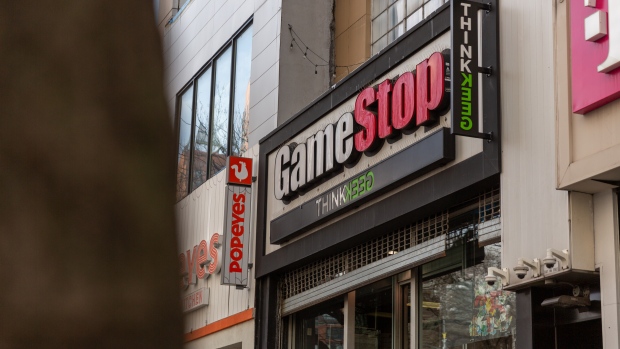May 28, 2024
The Daily Chase: GameStop shares popping again
, BNN Bloomberg

Here are five things you need to know this morning:
GameStop shares surging anew: When you dilute existing shareholders by issuing new shares, all things being equal, a share price is supposed to go down, not up. But such is the state of affairs with meme stock GameStop of late that its shares are doing the opposite this morning after the company says it took advantage of renewed interest in its stock this month by selling 45 million shares to raise US$933 million. The shares initially popped on Friday evening in after-hours trading when GameStop announced the share sale. But after the holiday long weekend, Tuesday morning was investors’ next chance to weigh in, and the stock is up by even more, now 27 per cent higher than where it was on Friday afternoon. It’s anyone’s guess what will happen next, but when it comes to GameStop’s stock price, the old adage about the weather holds true: if you don’t like it, just wait five minutes.
The U.S. stock market is finally as fast as it was about a hundred years ago… so goes the opening line of an excellent Bloomberg item today, outlining new rule changes that will allow same-day settlements of stock trades for the first time in decades. In the age where stock market trades were infrequent enough to be logged by hand, settling trades by transferring stock certificates was doable on the same day the trade happened. But as things got more hectic, the system built in extra days as a buffer zone to make sure the payment paperwork was above board. The explosion of retail investors in the 20th century eventually led to the creation of stock clearing houses to centralize processing, but the U.S. Securities and Exchange Commission is implementing new rules as of today to return to the era of so-called T+1 trading. You’d have to go back to the Roaring Twenties to find a time when stock sales were guaranteed to be processed on the same day. That gap eventually got as wide as five days, and was cut to three in the 1990s before being ratcheted down to two since 2017. But in the spirit of transparency, the SEC is changing the rules to mandate them back to how they used to be, and they aren’t alone: authorities in other jurisdictions including Canada, Mexico, India and elsewhere have similar systems now in force.
All that glitters is not gold, as silver hits multi-year highs too: With most major stock markets around the world closed yesterday for various holidays, the TSX quietly cranked out a solid little day, built mostly on the back of a continuing commodity bull run. Shares in gold and silver miners jumped as prices for precious metals continued their ascent to multi-year highs. Gold bullion is changing hands at US$2,356 an ounce this morning, just shy of the all-time high above $2,400 it hit last week. And silver is making gains too, changing hands at just shy of $32 an ounce. Outside of two brief spikes in the early 2010s and late 1970s, that’s the highest price on record. TSX-listed silver miners such as Pan American Silver Corp and Silvercrest Metals Inc. both gained about four per cent on the TSX yesterday.
CPP-backed health-care startup Waystar plans US$1B IPO: In a headline that feels like it would make the late, great Logan Roy crack a smile, health-care payments software firm Waystar Holding Corp. is seeking to raise more than US$1B in an initial public offering that values the company at almost four times that amount. The company filed paperwork early Tuesday suggesting the company’s backers, which include the Canada Pension Plan, Bain Capital, EQT and others, plan to sell 45 million shares on the Nasdaq for as much as $23 apiece. Once it happens, Waystar’s IPO will be the latest in what’s shaping up for a solid year for IPOs in the U.S., with $17 billion raised so far, and counting.
Bank of Nova Scotia beats earnings expectations even as bad loans mount: The Bank of Nova Scotia posted quarterly results before markets opened today, and numbers from the bank came in mostly higher than analysts were expecting. Adjusted profit came in at $1.58 per share, just ahead of the $1.56 expected, with strength in wealth management and capital markets making up most of the gains. The bank’s provisions for credit losses also inched up to just over $1 billion in the three months through April; in line with expectations.